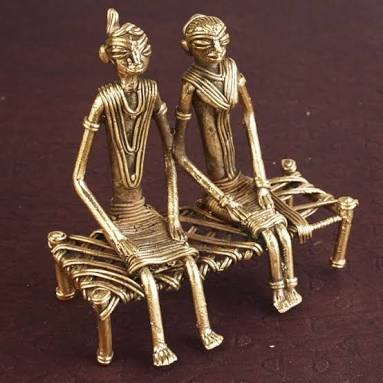
Dhokra art is the famous art of Chhattisgarh, making it favorite folk style for many customers, collectors, decorators, or furnishers etc. Dhokra art is inspired by tribal themes of animals, mythical creatures, human creatures, natural shapes etc. The region is rich tradition of craft and culture. The Dhokra craft is fiend in Bastar, which is a district in the southern part of the state of Chhattisgarh. Bastar is bound by the states of Orissa and Maharashtra on its east and west, respectively. Of the total population of bastar, more than 70% are tribal including the Gond, Abhuj Maria, Darda Maria, Bison Horn Maria, Munia Doria, Dhruva, Bhatra and Halba tribes. Other communities carrying out specific occupations are also found in the district, such as the Ghadwas, who are engaged in the Dhokra craft. The city of Raipur in Chhattisgarh is the most convenient place from where one can access Baster. The clusters in Bastar for the Dhokra craft are Kondagaon and Jagdalpur, which are situated 225 kms and 298 kms respectively from Raipur Dhokra art is the characteristic feature of Chhattisgarh art. Each piece of Dhokra art is characterized by intricate attention of the artist to provide its authenticity. It is an ancient method by which metal arty-crafts are made through wax casting techniques. It is an ecofriendly raft as it uses scrap useless metal.
Dhokra is a non- ferrous metal that is cast into various products by using the lost- wax casting technique. This sort of metal casting has been undertaken in India for over 4,000 years and the same method is still being used. One of the earliest known lost wax artifacts is the dancing girl of mohenjo-daro.Dhokra is the oldest form of metal casting and popular because of its simplicity. It is the specialty of Chhattisgarh. It is very important handicraft because of it labour extensive and largely exclusive folk character. Bastar district of Chhattisgarh provides the most distinct Dhokra crafts. Dhokra crafts are made manually by casting of brass and bronze metal with the help of wax vanishing technique. The process of making Dhokra craft is very old however; it provides such intricate works of the local deities, sun, moon, jungle, flora and fauna etc. to provide a decorative look on it.
History
The Dhokra craft has been discovered in the relics of the mohenjidaro and Harappan civilizations, which proves the historical and traditional importance of the industry. The statue of the dancing girl, unearthed at mohenjodaro is proof of the origin and continuity of the craft. It is this continuity of tradition, coupled with the intrinsic starkness and vitality of the art form, which makes Dhokra products coveted collectors’ items in India and Abroad for connoisseurs, scholars and laypersons alike. The Dhokra art is a major attraction in Bastar. The Ghadwas are small artisan groups who produce brass or bell metal objects. In Bastar, many folk stories are told about the origins of the Ghadwas, the foremost among which is the following tale: three hundred years ago, the ruler of Bastar, Bhan Chand was presented a gift, a necklace crafted in Dhokra craft for his beloved wife, which made him aware of the beauty of the craft. To honour the craftsman, he decided to bestow the title of Ghadwa on him, which is derived from the word ghalna, meaning to melt and work with wax. Therefore, since these people prepare the craft items by melting the metal through the use of the lost wax technique, they are given the name ‘Ghadwa’. Another derivation of the name comes from the word gadhna, which means to make. Ghadna means the act of shaping and creating, and it is probably this term that gives the artisans, who cast the objects, mainly made of brass and copper, their name. In some regions, the craftsmen are also called Ghasia, Khaser, Mangan, and Vishwakarma.

